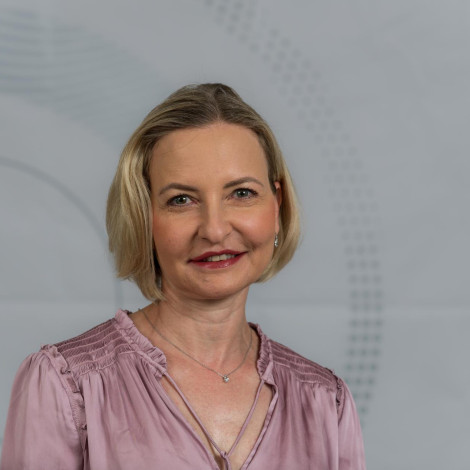
Prof. Hava Gil-Henn
Signal transduction, cytoskeleton, cell motility, cancer metastasis, brain and behavior
CV
Professor Hava Gil-Henn researches cytoskeletal signaling in health and disease.
1992-1995 Tel-Aviv University, Faculty of Life Sciences, Tel-Aviv, Israel.
B.Sc. degree, May 1996.
1995-1997 Tel-Aviv University, Faculty of Life Sciences, Department of Cell Research and Immunology.
Supervisor: Prof. Daniel H. Wreschner.
1998-2002 Ph.D. at the Weizmann Institute of Science, Rehovot, Israel
Department of Molecular Genetics.
Supervisor: Dr. Ari Elson.
2003-2008 Post-doctoral fellow at Yale University School of Medicine, Department of Pharmacology, laboratory of Dr. Joseph Schlessinger.
2008-2010 Associate Research Scientist at Yale University School of Medicine, Department of Molecular Biophysics and Biochemistry, laboratory of Dr. Anthony Koleske.
12/2010-07/2011 Visiting scientist at Albert Einstein College of Medicine, Department of Anatomy and Structural Biology, laboratory of Dr. John Condeelis.
10/2011 - present Senior Lecturer, Bar-Ilan University Faculty of Medicine, Safed, Israel.
10/2018-05/2019 Diploma studies: Genomics and Biomedical Informatics program, Bar-Ilan University, Ramat-Gan, Israel.
Research
Title of laboratory: Cytoskeletal Signaling Laboratory
Cytoskeletal remodeling is a fundamental biological process that requires accurate coordination of several molecular pathways and physical forces. From single-cell organisms searching for nutrients to complex neurons searching for synaptic partners, at some point in their life cycle most cells must remodel their cytoskeleton to change their shape or move. Understanding how cells encounter and sum a multitude of signals in their complex extracellular environment and translate these signals into the complex processes which regulate cell shape and movement is of great importance to biology. The molecular details of these processes and the complex signaling pathways and networks that regulate them are only starting to be revealed at present. Research in our laboratory focuses on cytoskeletal signaling by non-receptor tyrosine kinases, cellular relays that translate information from cell surface growth factor and adhesion receptors to promote downstream events such as enzymatic activities, cytoskeletal reorganization, gene expression, and synaptic plasticity. We use a multidisciplinary approach, which combines advanced molecular and cellular biology methods, in vitro and in vivo RNAi-mediated genetic manipulations, transgenic and knockout mice models, cutting-edge in vivo methods, high-resolution fluorescent and intravital imaging, and in vivo transcriptomics/proteomics followed by integrated bioinformatics and systems biology analyses, to understand and characterize, at the molecular, cellular, and whole-organism levels, the cytoskeletal signaling networks that regulate normal physiological processes and their modifications leading to human disease. A better understanding of the cytoskeletal mechanisms and signaling pathways that regulate and execute these processes could suggest novel clinical targets and strategies for the diagnosis and treatment of human diseases such as cancer metastasis, wound healing, brain disorders, and Alzheimer’s disease, and is a fundamental goal of our research.
Publications
Hava Gil-Henn, Jean-Antoine Girault, and Sima Lev (2023). PYK2, a hub of signaling networks in breast cancer progression. Trends in Cell Biology, Aug 15: S0962-8924(23)00139-3. doi: 10.1016/j.tcb.2023.07.006. Online ahead of print
Hava Gil-Henn, Antonia Patsialou, Yarong Wang, Michael Sloan Warren, John Condeelis, and Anthony Koleske (2013). Arg/Abl2 promotes invasion and attenuates proliferation of breast cancer in vivo. Oncogene 32, 2622-30.
Tomer Meirson, Abraham O. Samson, and Hava Gil-Henn (2017). An in silico high-throughput screen identifies potential selective inhibitors for the non-receptor tyrosine kinase Pyk2. Drug Design, Development, and Therapy 11, 1535-1557.
Alessandro Genna, Stefanie Lapetina, Nikola Lukic, Shams Twafra, Tomer Meirson, Ved P. Sharma, John S. Condeelis, and Hava Gil-Henn (2018). Pyk2 and FAK differentially regulate invadopodia formation and function in breast cancer cells. The Journal of Cell Biology 217, 375-395.
Tomer Meirson, Alessandro Genna, Nikola Lukic, Tetiana Makhnii, Joel Alter, Ved P. Sharma, Yarong Wang, Abraham O. Samson, John S. Condeelis, and Hava Gil-Henn (2018). Using ABL kinase inhibitors to block breast cancer metastasis. Oncotarget 9(31), 22158-22183.
Tomer Meirson and Hava Gil-Henn (2018). Targeting invadopodia for blocking breast cancer metastasis. Drug Resistance Updates 39, 1-17 (invited review).
Kolluru D. Srikanth, Tomer Meirson, Dev Sharan Sams, and Hava Gil-Henn (2018). FAK family kinases in brain health and disease. Journal of Molecular and Clinical Medicine 1(3), 177-190.
Liat Ninio, Abraham Nissani#, Tomer Meirson#, Tom Domovitch, Alessandro Genna, Shams Twafra, Kolluru D. Srikanth, Roba Dabour, Erez Avraham, Ateret Davidovich, Hava Gil-Henn*, and Meital Gal-Tanamy* (2019). Hepatitis C virus induces hepatocellular carcinoma invasiveness via generation and activation of invadopodia. Cells 8(11), 1395.
Jonathan Solomon, Magdalena Raška, Daniel Rösel, Jan Brábek, and Hava Gil-Henn (2021). Are we ready for migrastatics? Cells 10(8), 1845.
Trishna Saha, Jonathan Solomon, Abraham O. Samson, and Hava Gil-Henn (2021). Invasion and metastasis as a central hallmark of breast cancer. Journal of Clinical Medicine 10(16), 3498 (invited review).
Trishna Saha and Hava Gil-Henn (2021). Invadopodia, a kingdom of non-receptor tyrosine kinases. Cells 10(8), 2037.
Nikola Lukic, Stefanie Lapetina, Kolluru D. Srikanth, Shams Twafra, Jonathan Solomon, and Hava Gil-Henn (2021). Pyk2 regulates cell edge protrusion dynamics by interacting with Crk. Molecular Biology of the Cell Nov 1;32(21):ar17.
Nikola Lukic, Trishna Saha, Stefanie Lapetina, Gilad Lehmann, Anthony J. Koleske, and Hava Gil-Henn (2021). Measuring cell-edge protrusion dynamics during spreading by using live-cell microscopy. JoVE Nov 1;(177):10.3791/63157.
Shannon L. Gourley, Kolluru D. Srikanth, Ellen P. Woon, and Hava Gil-Henn (2021). Pyk2 stabilizes striatal medium spine neuron structure and striatal-dependent action. Cells 10(12):3442.
Bisan Saleh, Kolluru D. Srikanth, Tal Sneh, Lambert Yue, Steven Pelech, Evan Elliott, and Hava Gil-Henn (2022). FAK-mediated signaling controls amyloid beta overload and learning and memory deficits in a mouse model of Alzheimer’s disease. International Journal of Molecular Sciences 23(16): 9055.
Shams Twafra, Chana G. Sokolik, Tal Sneh, Kolluru D. Srikanth, Tomer Meirson, Alessandro Genna, Jordan H. Chill, and Hava Gil-Henn (2022). A novel Pyk2-derived peptide inhibits invadopodia-mediated breast cancer metastasis. Oncogene 42(4): 278-292.
Last Updated Date : 14/11/2023



